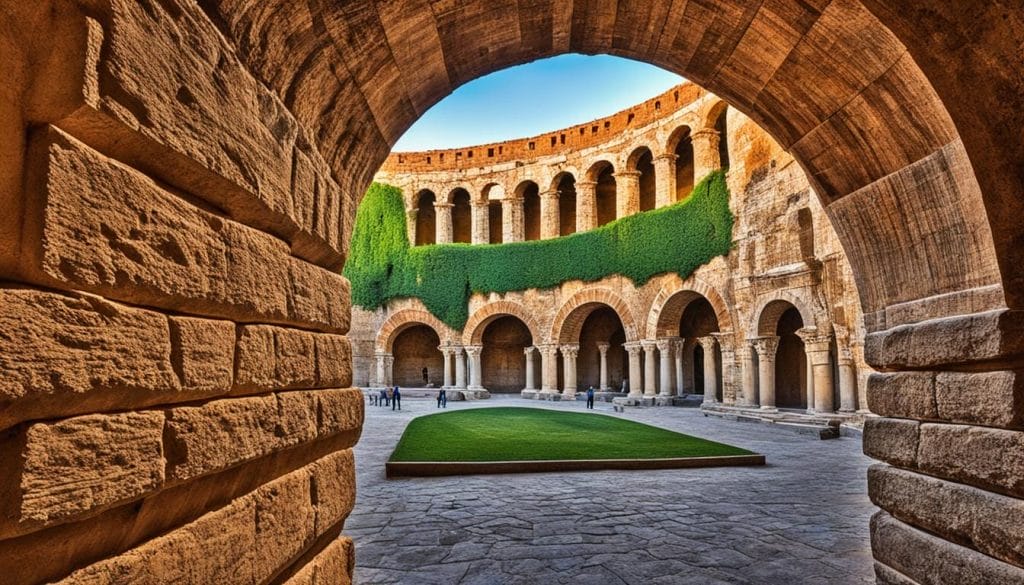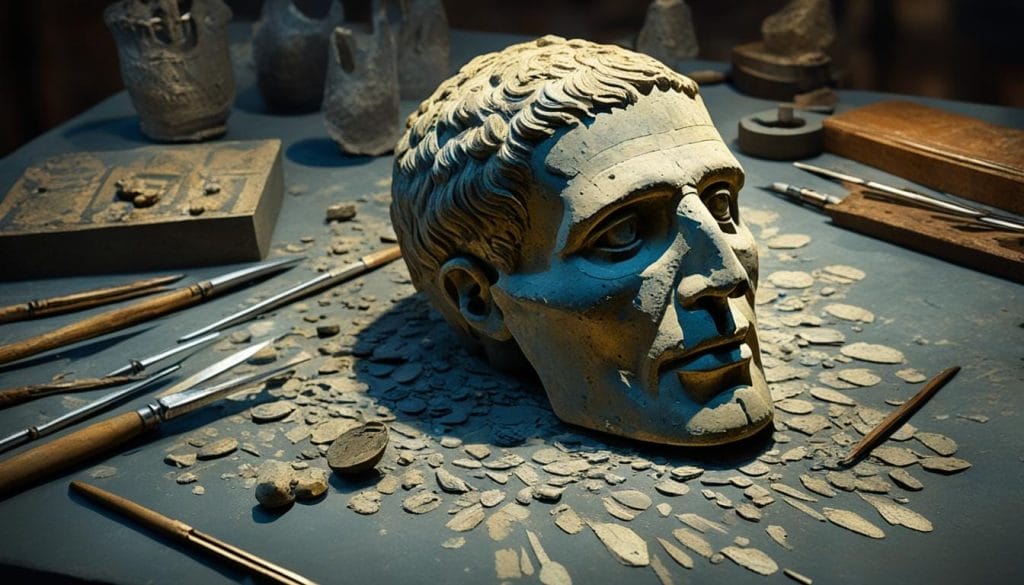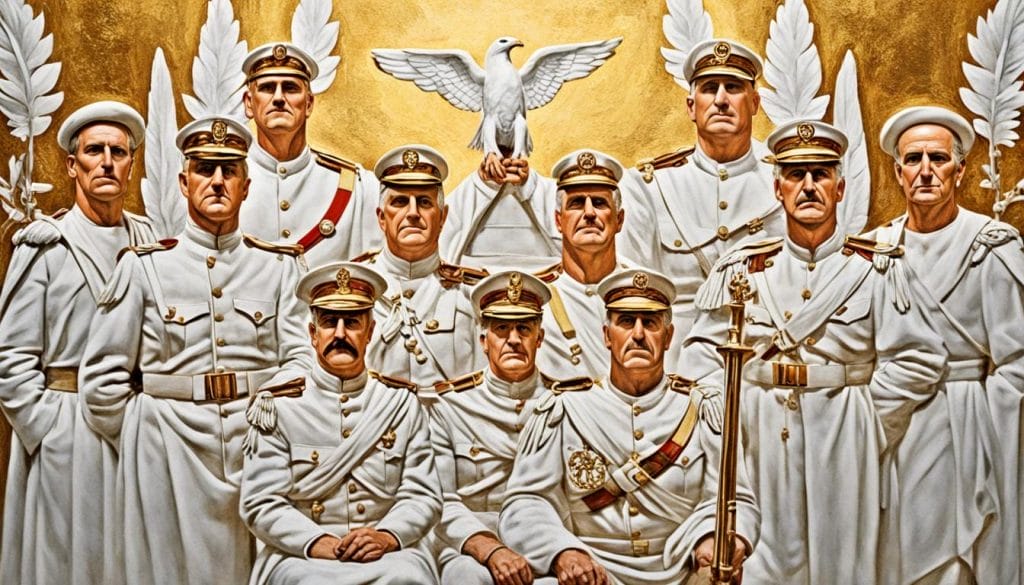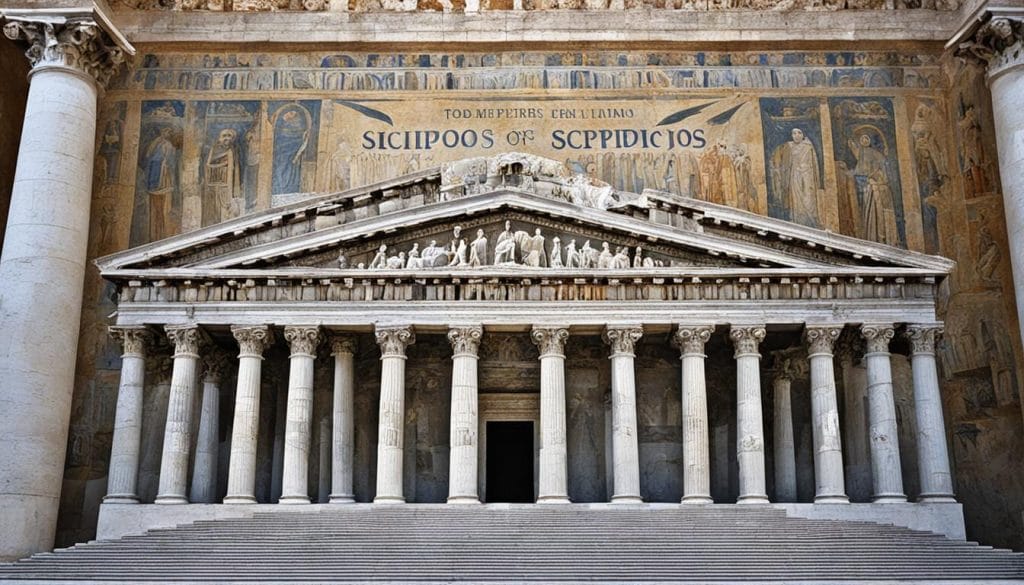Among the cobbled lanes and ancient edifices of Rome lies a monument steeped in history, the Scipios family tomb. This historical patrician burial site has stood as a silent witness to the ebb and flow of time, safeguarding the remnants of one of the most illustrious families of ancient Rome. The tomb, originating in the culturally rich epoch of the 3rd century BC, encapsulates the grandeur and the gravitas of an era that shaped the Western world. Despite its initial creation for the noble Lucius Cornelius Scipio Barbatus, its magnificence became the eternal abode for his kin, a necropolis embracing generations of Scipios who left their indelible mark on history.
Buried within its walls are tales of valor, politics, and the everyday life of the patricians, inviting modern explorers to delve deep into Rome’s storied past. This burial site, once lost to vineyards and time, was uncovered to narrate the saga of a family central to Rome’s ascendancy. Today, the tomb beckons history enthusiasts and curious minds alike to uncover the layers of its ancient splendor.
Key Takeaways
- The tomb is an emblematic historical patrician burial site of Rome, inviting exploration and admiration.
- Though its connection to Cornelius Scipio Africanus is popular, he does not rest within its walls—yet, the site epitomizes the Scipios’ valor and influence.
- Rediscovered in 1780, the tomb’s true grandeur and heritage have been unearthed for the world to appreciate.
- As a treasure trove of the Scipios’ legacy, it holds within it the echoes of military triumphs and ancient societal structures of ancient Rome.
- The resilience of the tomb through centuries underlines the enduring fascination with Roman civilization and its notable figures.
The Scipios: A Storied Lineage of Ancient Rome
When delving into the illustrious annals of ancient Rome, one cannot overlook the storied legacy of the Roman patrician family, the Scipios. This venerable line produced some of the most revered military heroes known to history, including the eminent Scipio Africanus. Hailed for his pivotal victory over Hannibal at the Battle of Zama, Scipio brought unparalleled honor to his kin and to the Roman Empire.
The onset of their narrative began with Lucius Cornelius Scipio Barbatus, himself a consul of Rome, who established a grand tomb that would eventually serve as the sacrosanct resting place for generations of Scipios. Beyond its role as a final resting place, the tomb symbolized the Scipio clan’s towering influence within Rome; their contributions were felt in royal courts and the Empire’s political stratum alike.
- Engraved epitaphs reveal tales of valor and virtue,
- Marble statues reflect an aura of nobility and strength,
- Echoing corridors tell the silent stories of a familial dynasty.
Herein rest the Scipios, bearers of Rome’s standard and guardians of its imperium.
| Scipio Member | Contribution to Rome | Era |
|---|---|---|
| Cornelius Scipio Africanus | Defeated Hannibal, Peace of Africa | 3rd Century BC |
| Lucius Cornelius Scipio Barbatus | Consul, Tomb Founder | 3rd Century BC |
| Publius Cornelius Scipio Aemilianus | Conqueror of Carthage and Numantia | 2nd Century BC |
This prominent Roman patrician family stood at the forefront of military innovation and strategic governance, cementing their place in history as archetypes of Roman strength and wisdom. Their narrative, encapsulated within the walls of their familial tomb, continues to fascinate historians and visitors alike. It is a chapter of antiquity marked by ambition, triumph, and an enduring legacy that whispers to us from the ruins of Rome.
The Architectural Marvel of The Tomb of the Scipios
The iconic consul Lucius Cornelius Scipio Barbatus not only left a legacy as a renowned figure of ancient Rome but also through the magnificent structure known as the Tomb of the Scipios. This ancient construction began as a family burial but soon transformed into an illustrious Roman necropolis. It stands today as a testament to the rich historical tapestry of Rome, reflecting the once-powerful Scipio dynasty’s status and reverence.

The Origins and Grandeur of the Tomb
Originally a singular sepulcher, the Tomb of the Scipios evolved into a grand burial complex, capturing the essence of Roman architectural grandeur. A synthesis of art and eternity, the necropolis sprawled into an elaborate symbol of the family’s prosperity and the revered status of consul Lucius Cornelius Scipio Barbatus, whose vision laid its foundations.
Rediscovery and Public Acclaim
After fading into obscurity, the site underwent a dramatic rediscovery of Roman site in 1780. This remarkable incident unveiled a historical treasure trove beneath a seemingly ordinary vineyard, bringing into light its precious archaeological value. The subsequent purchase by the city in 1880 was a pivotal step in preserving its antiquity for future exploration and admiration.
Modifications Over the Centuries
Despite the passage of time and inevitable tomb alterations, the core identity of the Tomb of the Scipios prevails. Various archaeological changes have introduced a new facade to its entrance, yet the alterations have not diluted its historical essence. Instead, each modification layers the narrative, connecting past and present, and inviting onlookers to probe deeper into the annals of Rome.
Artifacts and Sarcophagi: Etruscan Influences and Rome’s Glory
The exploration of the ancient Roman past is incomplete without acknowledging the stunning artifacts discovery that sheds light on the multi-layered history of this civilization. Among the most captivating finds are the intricate artifacts and fragmented sarcophagi unearthed within the storied confines of the Tomb of the Scipios. These relics not only connect us to the Roman world but are indicative of the rich Etruscan and Greek influences that permeated their society. Now part of the prestigious Vatican Museum exhibition, these objects serve as a bridge between the modern admirer and the ancient artisan, revealing a cross-cultural dialogue entrenched in clay, stone, and artistry.
The exhibition features a curated selection that mirrors Rome’s grandeur. Each piece, a narrative in itself, echoes the tales of a civilization that has long fascinated historians and art-lovers alike. Below is a table highlighting key artifacts and their respective characteristics, as seen in the Vatican Museum’s display, which illustrates the mingling of artistic heritages that thrived in the heart of the Roman empire.
| Artifact Description | Origin Influence | Period | Material |
|---|---|---|---|
| Sarcophagus Fragment with Battle Scene | Etruscan | Late Republic | Marble |
| Priest Bust with Ritual Garb | Greek | Early Empire | Bronze |
| Decorative Cornice with Floral Motifs | Etruscan-Greek Hybrid | Mid Republic | Terracotta |
| Funerary Urn Inscribed with Latin Epitaph | Latin | Late Republic | Stone |
These artifacts are not mere remnants of the past; they are symbols of Rome’s eternal dialogue with neighbouring cultures – a testament to their willingness to absorb diverse artistic techniques and preferences. The exhibition at the Vatican Museum offers an extraordinary chance to experience firsthand the legacy of societies that laid the cornerstone for the cultural landscapes we cherish today.
The Enigmatic ‘Head of Ennius’ and Other Discoveries
Within the depths of history, the 1934 discovery of the ‘Head of Ennius’ stirred the waters of archaeological significance. This distinguished artifact, echoing the Etruscan and Greek styles, was abruptly swept away by an act of artifact theft, deepening the mystery of its existence and depriving historians of a crucial piece of ancient Roman puzzle.

The misfortune of the ‘Head of Ennius’ theft did not overshadow its artistic influence on the Rome of old. The delicate interplay of Etruscan craftsmanship and Greek aesthetic ideals adds to the narrative that Rome was not just a hub of power but also a melting pot of cultures.
1934 Discovery: The Theft of History
The unexpected discovery and subsequent loss of the ‘Head of Ennius’ remain a poignant reminder of the ever-present threats to our shared cultural heritage. The theft of such ancient artifacts is a theft from humanity itself, denying future generations the knowledge and inspiration that comes from direct contact with our ancestors’ artistry.
Connection to Etruscan and Greek Art
Evidenced within the contours and expressions of the ‘Head of Ennius’, we witness the pervasive reach of Etruscan and Greek styles into the fabric of Roman society. Artifacts like these are testimonies to the ancient world’s interconnectedness and mutual artistic influence.
| Artifact | Cultural Influence | Significance |
|---|---|---|
| Head of Ennius | Etruscan and Greek | Exemplifies the fusion of artistic norms affecting Roman culture |
| Second Sculpture | Greek | Reflects the dominant Greek aesthetic within Roman art |
| Decorative Frescoes | Etruscan | Demonstrates the influence of regional Etruscan styles in burial practices |
Cornelius Scipio Africanus: The Hero behind the Name
The tide of the Second Punic War turned at the Battle of Zama when Cornelius Scipio Africanus engineered one of the most significant Roman military triumphs. This decisive battle not only solidified Rome’s power but marked the end of Hannibal’s invasions, ushering in a period of peace and hegemony for Rome in the ancient world.
The Battle of Zama and Defeat of Hannibal
The confrontation at Zama, occurring in 202 BCE near Carthage, was instrumental in ending over a decade of conflict. Clever military tactics and an adaptable strategy allowed Scipio’s forces to break Hannibal’s previously indomitable war elephants, capturing imaginations for millennia as a keystone event in military history. While much of the historical records detail the larger narrative of the Punic Wars, it’s Scipio’s leadership that remains a lustrous beacon in the annals of history.
Lost Writings and the Legend of Scipio
Although the victory was grand, a poignant gap exists in recorded history due to Scipio’s lost writings. What remains today consists of ancient inscriptions, disparate archaeological records, and second-hand accounts scripted by those who came after. These fragments, though minimal, weave together the intricate tapestry that celebrates Scipio’s strategy, bravery, and his ultimate devotion to Rome. The lack of direct sources doesn’t diminish the legend but rather enhances the enigmatic aura that surrounds Scipio Africanus.
| Event | Description | Significance |
|---|---|---|
| Battle of Zama | Final battle of the Second Punic War, led by Scipio Africanus. | Decisive Roman victory that ended Carthaginian power. |
| Scipio’s Tactics | Innovative use of infantry and countering of war elephants. | Highlighted Scipio’s tactical genius and military vision. |
| Historical Impact | Limited direct records, heavily reliant on later interpretations. | Preserved Scipio’s legacy as a legendary Roman figure. |
The Wisdom of Polybius and the Legend of Scipio
In the tapestry of historic writings, few threads are as vibrant as the accounts of Polybius. This pivotal historian of classical antiquity brought a unique perspective to the events and figures of the ancient world, with a particular emphasis on the accomplishments of Scipio Africanus during the Punic Wars. Through his chronicles, Polybius provided us with an exquisite blend of factual recount and stoic deliberation – an approach that greatly influenced how future generations perceived the legendary commander.

Far from mere historical record, Polybius’s body of work is imbued with stoic philosophy, an aspect evident in his portrayal of Scipio as a paragon of rational virtue. His depiction may have sparked debates over its accuracy in representing Scipio’s character, but there is no denying that Polybius has added depth and nuance to the legend of a military genius revered throughout time.
Let’s consider the implications of Polybius’s stoic narrative:
- It elevates Scipio from the realms of mere mortal to an almost mythological figure, framed within the ethics and virtues extolled by stoicism.
- Polybius’s narrative has been critical in shaping historical understanding; the clash between Carthaginian and Roman ideologies is often contrasted through the lens of his accounts.
- The intertwining of factual history with the principles of stoic philosophy can be seen as an effort to find meaning and moral instruction in the unfolding of events.
While the historian’s works continue to inspire keen interest, they prompt us to ponder how the interplay of stoic philosophy and factual recount has colored our view of past civilizations. Polybius did not just record history; he crafted a philosophical drama where figures like Scipio became enduring symbols of wisdom and virtue.
“History is philosophy teaching by examples.” – This sentiment, attributed to Polybius, encapsulates the foundational belief that through understanding historical events, one can grasp deeper life lessons.
Engaging with the works of Polybius allows us to appreciate the vast intellectual landscape of our ancestors. His insights are a bridge to understanding not only what people did but also their beliefs, struggles, and the philosophies that might have guided them. Indeed, Polybius’s contributions remain a cornerstone for those who seek to unravel the rich tapestry of ancient history and the enduring legacies it has bequeathed to the world.
Resurgence of the Scipios: Historical Impact and Modern Interpretations
The Scipio family personifies the grandeur and complexity of Roman Empire history, leaving a legacy that resonates through the annals of time. Their profound political influence and cultural impact have crossed the boundaries of their era to inform and inspire our understanding of Roman heritage today.
The Scipio Bloodline in the Context of Imperial Rome
The Scipio family legacy was cemented by their strategic engagements that shaped the very framework of the Roman Empire. Their revered place within society was characterized by a distinct blend of military prowess, shrewd political maneuvering, and the patronage of arts and philosophy. The reach and relevance of the Scipios extended far beyond military encounters, influencing the cultural tapestry and governance throughout Rome’s imperial zenith.

The Lasting Influence on Roman Culture and Politics
Even in the present day, the legacy of the Scipios continues to be an intrinsic part of the narrative around ancient Rome. Whether it’s through museum exhibits that showcase artifacts from their grand necropolis, or through scholarly debates over their role in shaping the political discourse of the time, the Scipios’ contribution to Roman civilization remains a point of fascination and study. Their story, echoing through centuries, offers a window into the enduring spirit of Rome and its lasting imprint on the world’s historical consciousness.
Visiting The Tomb of the Scipios Today
As a premier tourist attraction, the Tomb of the Scipios offers history aficionados a rare glimpse into the past of an ancient patrician family. This Roman historical site extends an invitation to journey through the corridors of time, amidst the remnants of a lineage that shaped the course of an empire.

Upon entering the tomb, visitors are enveloped by the essence of Ancient Rome, surrounded by the enduring legacy of Cornelius Scipio Africanus. It’s an intimate experience where the whispers of history reverberate off the ancient walls, allowing one to connect with the lives of those who influenced the paths of legions and the destiny of Rome itself. Whether a history buff, an enthusiast of archaeological sites, or someone seeking to touch the fabric of the Roman legacy, the site is a profound experience available for a nominal admission fee.
Wandering through the narrow passageways, the impact of the Scipio family becomes palpable, as the reality of standing in the same spaces where they once laid to rest dawns with every step forward. The opportunity to stand where the Scipios were memorialized allows for a profound personal engagement with history, far beyond what books and museums can convey.
“To walk through the Tomb of the Scipios is to traverse the shadowy lines of history, where the echoes of a once-dominant Roman family can still be heard.”
Visitors leave with a heightened sense of connection to the ancient world, carrying with them the stories and the spirit of one of Rome’s most revered families. The Tomb of the Scipios remains an unmissable attraction for all who visit the Eternal City, a testament to the enduring allure of its historical majesty.
Chronicles of the Scipios: Ancient Texts and Modern Reception
The narrative of the Scipios has traversed epochs, entwining the threads of ancient nobility with our contemporary understanding of Roman civilizational grandeur. The threads of their remarkable lineage are spun not just through the remnants of their storied tomb but also via the invaluable historical accounts of Polybius and the detailed dialogues of Cicero. These ancient Roman texts construct much of our foundational knowledge about the Scipios, revealing the depth of their influence on Rome’s history. An immersion into these classical writings is akin to walking alongside the Scipios themselves, within the echelons of ancient society.
Understanding the Scipios through Polybius and Cicero
What we discern about the Scipios’ lives and their epochal significance is profoundly shaped by historical accounts, among which Polybius’s chronicles stand tall. His meticulous accounts provide a lens through which we can view the stature and societal contributions of the family. Complementing Polybius’s narratives are Cicero’s dialogues, which often navigate the path of the Scipios’ legacy within Rome’s legal and political circles. Both collections of writings are indispensable for any earnest scholar or enthusiast seeking to comprehend the fame and the strategic prowess the Scipios wielded in their time.
Contemporary Works: The Continuance of a Legacy
In the compelling tapestry of ancient lore and allusion, “Roman Nights” by Alessandro Verri further endears the Scipios to the annals of historical imagination. Infused with Romanticism, Verri’s work stands as a testament to how historical narratives can be reenvisioned, inspiring a new generation to delve into the past. Through such contemporary reimaginings, the torch of the Scipios’ narrative is kept alight within the realm of our cultural memory, affording us a gaze into the opulent and complex world of Rome that these patricians once navigated with renown and valor.
FAQ
What is the Tomb of the Scipios and why is it significant?
The Tomb of the Scipios is a historical patrician burial site that served as the eternal house for the Scipios, an influential Roman patrician family known for their military heroes and contributions to ancient Rome from the 3rd century BC to the 1st century AD. Its significance stems from the family’s prominent role in Roman society and the site’s rich archaeological value.
Was Cornelius Scipio Africanus buried at the Tomb of the Scipios?
No, despite his fame and close association with the Scipios family tomb, Cornelius Scipio Africanus was not buried there. The tomb was originally established by Lucius Cornelius Scipio Barbatus but later housed other members of the Scipio family.
How was the Tomb of the Scipios rediscovered?
Lost for centuries, the Tomb of the Scipios was rediscovered in 1780 beneath a vineyard. It was later purchased by the city of Rome in 1880, recognizing its precious archaeological value and ensuring its preservation and public access.
Are there any notable artifacts discovered in the Tomb of the Scipios?
Yes, several artifacts and fragments of sarcophagi, showcasing influences from ancient Etruscan and Greek art, were found within the tomb. Some of these artifacts are now exhibited at the Vatican Museum, highlighting the cultural exchanges of the time.
What happened to the ‘Head of Ennius’ after it was discovered in the tomb?
The ‘Head of Ennius’, an artifact dating back to the 3rd century BC, was discovered in the tomb in 1934. Not long after its discovery, the piece was stolen, which added a layer of mystery to the tomb’s history. The theft underlines the ongoing struggle to protect and conserve ancient artifacts.
What impact did Cornelius Scipio Africanus have on Roman military history?
Cornelius Scipio Africanus is celebrated for his military genius, particularly his role in the Battle of Zama during the Second Punic War, where he defeated Hannibal. His achievements remain a cornerstone of Roman military history, despite many of his own writings not surviving through time.
Who was Polybius, and how does his work contribute to our knowledge of Scipio Africanus?
Polybius was a Greek general and historian who lived several decades after Scipio Africanus. His writings provide a rational and stoic perspective on the events of the Punic Wars and offer valuable insights into Scipio’s life and the legendary aspects that surrounded him.
How has the Scipio family impacted modern views of Roman history and culture?
The Scipio family legacy has had a lasting influence on Roman culture and politics. Their story continues to resonate in modern times, as evidenced by museum exhibits, literary works, and scholarly studies that explore the historical impact of the patrician family within the broader context of Roman heritage.
Can the public visit the Tomb of the Scipios?
Yes, the Tomb of the Scipios is open to the public as a tourist attraction for those interested in Roman history. Visitors can view the resting place of this ancient patrician family for a small admission fee, journeying back in time to marvel at the family’s storied past.
What are some significant historical texts that help us understand the Scipio family?
Primary historical accounts from Polybius, the dialogues of Cicero, and “Roman Nights” by Alessandro Verri offer insights into the Scipio family. These texts provide valuable perspectives on the family’s narrative and cultural significance in ancient Rome.
Source Links
- https://www.mediastorehouse.com/galleries/scipios
- https://www.ancient-origins.net/ancient-places-europe/hannibal-s-conqueror-brings-everlasting-glory-scipios-family-tomb-007910
- https://qcurtius.com/2021/03/14/arousing-the-imagination/
